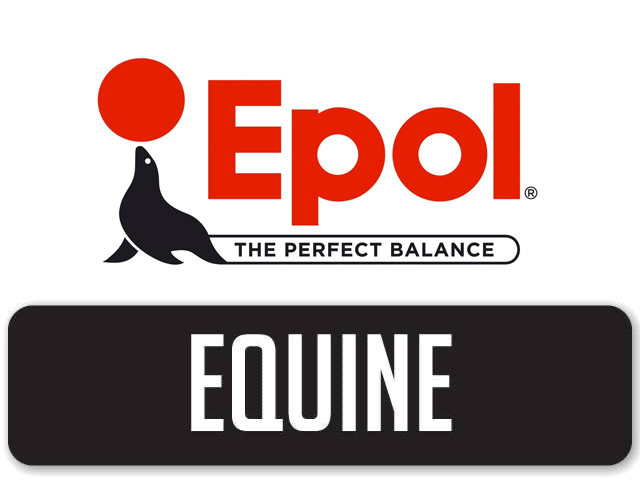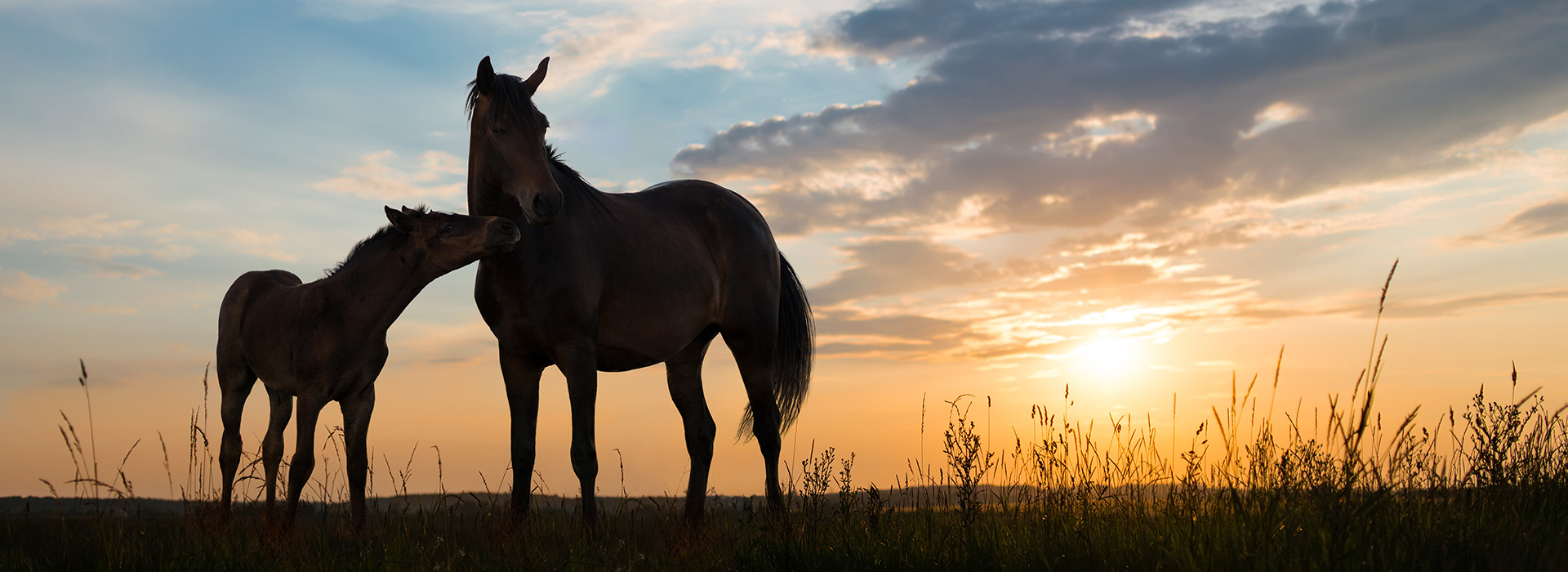Lucerne hay enjoys a varied reputation amongst horse people, with some using it as a highly valued component of their horse’s diet and others avoiding it with an almost religious fervour. But who is correct?
Most experts in the field of equine nutrition today endorse the traditional view that Lucerne as a roughage should be used in moderation and fed in combination with other hay sources in order for the total roughage component to be at a ratio of about 3: 1 – i.e. 75% Alternative hay sources to 25% Lucerne hay.
This newsletter article endeavors to shed some light on the advantages and risks associated with feeding Lucerne.
Lucerne Hay – What is it?
Lucerne hay is made from the Lucerne plant (Medicago sativa), a temperate perennial plant which originated in the Middle East. The Lucerne plant is a leguminous plant species, meaning that it belongs to the legume family of plants, that produce seed pods and have nodules on their roots that are capable of taking inert nitrogen from the atmosphere and converting it to organic nitrogenous compounds that are available to the plant.
The Lucerne plant may be cut to make Lucerne hay at various times during the plant’s life cycle, but is most commonly cut at the 10% flowering stage. Lucerne hay, when it is produced and stored correctly is commonly green in colour and should, on closer inspection, contain a high percentage of leaf material and fine stems. Lucerne hay that has been weather damaged or baled when too dry will be dull green to brownish in colour, and will commonly contain a high percentage of stems and a much lower leaf content.
The Nutrient Profile of Lucerne Hay
Lucerne hay is a high protein forage and also contains more energy than grass hays like Teff and Eragrostis. Lucerne also contains high concentrations of Calcium and Magnesium and, when fresh, also vitamins A and E.
Lucerne is however typically low in Phosphorous and depending on where it was geographically grown, contains varying concentrations of other macro and micro minerals. Below shows an abbreviated nutrient profile of early bloom Lucerne hay in comparison to grass hay and oaten chaff.
Profile | Lucerne Hay | Grass Hay | Oaten Chaff |
| Digestible Energy (MJ/kg) | 9.37 | 7.5 | 7.32 |
| Crude Protein (g/kg) | 180 | 95 | 86 |
| Calcium (g/kg) | 12.8 | 5.0 | 2.9 |
| Phosphorous (g/kg) | 1.9 | 2.2 | 2.3 |
| Magnesium (g/kg | 3.1 | 1.9 | 1.5 |
Note the very wide Ca to P ratio of Lucerne in comparison to the other hays.
Main Advantages of Lucerne
The main advantages from a nutritional point of view are:
- High Protein content- ideal for animals that are growing or in need of repair
- Good quality Protein
- High fibre content
- High content of most minerals
- High Vitamin content especially when fresh and green
- Fair digestibility
- Mostly very palatable.
Risks and important aspects to be aware of!
1) Variation in Quality
One of the important factors to consider is the huge variation that can exist between various batches of Lucerne. Ideally batches should be tested before use to ensure the quality is consistent, however this not really practical in SA, so it should be kept in mind when building a diet frame work for your horse.
Between various cuttings Protein content can vary by 43% and the fibre content by 60%. It is also important to note that the Protein quality can be hugely affected with the lysine value dropping by 50% from 11.8g/kg to as low as 7.9 g/kg. The digestibility was also determined and reduced by 56% towards the last cutting.
Other studies shows that Lucerne grown in alkaline soils can have magnesium levels of up to seven times as high as the normal levels, again emphasizing the problems and risks involved with variations in composition.
Even with the large drop in values Lucerne remains a very nutritious fibre but this does partly explain why it is not recommended to use Lucerne as the sole source of fibre.
2) Imbalance in the Phosphorous to Calcium Ratio.
Most people are aware that Calcium is an essential nutrient and mineral in the development of a strong and healthy bone structure. The increased requirement for dietary Calcium in the nutrition of pregnant mares, young and growing horses (especially if in training), is well known by most owners and trainers. It is not so commonly known however that the ratio of Calcium to Phosphorus in the diet is as crucial as the inclusion of Calcium itself. It is also important to understand that certain foodstuffs contain Calcium and Phosphorus in forms that are unavailable to the horse. This is because certain chemicals in feeds such as oxalates and phytates bind Calcium so that the horse cannot digest it.
Calcium is not only involved in structural components of the body such asteeth and bones, but is also extremely important in its dissolved form for processes such as muscle contraction, blood clotting and as a messenger molecule in cells within the body. So important is its role that the body keepsthe amount of dissolved Calcium between strictly controlled levels through a process known as homeostasis.
The body regulates the dissolved Calcium levels by drawing on Calcium in the bones in times of need, and by ensuring that excess Calcium is deposited in the bones in times of good supply. A hormone called the parathyroid hormone regulates this homeostatic process. Parathyroid hormone in conjunction with vitamin D help to keep the balance of Calcium to Phosphorus in the bones in a ratio of around 2:1.
Why is Lucern’s high Calcium content a disadvantage?
When horses are fed Lucerne as the sole roughage, Calcium is supplied well in excess of their daily requirements. For example, 5kg of Lucerne supplies 70g of Calcium, which is more than twice the daily requirements of a 400kg horse at hard work. In response to this large and continuous supply of Calcium in the diet, the body will adjust its calcium-regulating hormone levels accordingly – the Calcitonin responsible for storing Calcium will increase, and levels of parathyroid hormone will decrease. From the body’s point of view, there is no need to maintain high levels of a Calcium-mobilizing hormone when excess Calcium is consistently provided in the diet.
This supply-and-demand concept can become a problem during strenuous events. Since Calcium is required in large amounts for muscular contractions, plasma Calcium levels gradually fall as the duration and intensity of exercise increases. In response to falling plasma Calcium levels, the body calls upon parathyroid hormones to mobilize more Calcium from its storage depots in the bone. However, because the body has become accustomed to having excess Calcium available from the diet, it can happen that the concentration of parathyroid hormones is too low to adequately supply stored Calcium quickly enough to meet the sudden high demand. In other words, there are not enough workers available at a moment’s notice to move Calcium from storage into circulation. As a result, plasma Calcium levels may continue to fall, increasing the likelihood of metabolic problems such as Tying Up and Thumps.
3) Other Mineral Deficiencies.
It also must be kept in mind that Lucerne hay is not a complete feed and will more often than not contain insufficient concentrations of trace minerals, in particular Copper and Zinc, to support sound musculoskeletal development.
- Zinc is essential in bone, cartilage and hoof formation. Deficiency can result in reduced appetite, retarded growth, dry thickened skin and hair loss in severe deficiencies.
- Copper is required for the development of bone, joint cartilage and connective tissues but also plays a role with metabolic and tissue anti-inflammatory enzymes. Deficiency can result in lameness in growing horses as well as anemia.
To which horses can Lucerne hay be fed?
Lucerne hay may safely be fed to all classes of horses; however, due to its high protein and relatively high energy characteristics, it must be fed to horses in controlled quantities to prevent problems that may be caused by excess energy and protein in the diet. The suitability of Lucerne hay for different classes of horses is discussed in more detail below:
Growing horses
When feeding Lucerne to growing horses, the amount fed should not exceed the growing horse’s energy requirements. Growing horses fed energy in excess of their requirements have a much higher chance of suffering from developmental orthopaedic diseases including osteochondritis dissecans (OCD). Note that High Protein levels are not indicated in the cause of OCD, and protein is vital for all growing aniamls.
Feeding protein in excess of the growing horse’s protein requirements does not appear to be detrimental and cause issues such as OCD as the protein can be utilised as a source of energy. Moderation seems to be the key, and again, a mixture of other hay and Lucerne (+/- 3:1) will keep you on the safe side.
Pregnant and Lactating Mares
When feeding the pregnant mare Lucerne hay, care must be taken not to exceed her energy requirements which will then cause her to become overweight. Conversely, Lucerne hay alone will not be capable of meeting the early lactation mare’s energy requirements and her Phosphorous and trace mineral requirements will also not be met by a diet based mainly on Lucerne hay. Depending on pasture conditions, mares need to be fed a good quality concentrate to maintain body condition throughout lactation.
As with growing horses, excess protein in the diet of pregnant and lactating mares does not appear to be harmful, however, it is an unnecessary waste of this relatively expensive feed component and should be avoided if possible.
Performance Horses in work or training.
With performance horses, as with growing horses and pregnant mares, Lucerne must be fed in moderation. Unlike the above classes of animals, excess protein in the diet of working horses, particularly those that are stabled, can be detrimental to their health and performance.
Excess protein intake will increase urinary ammonia production, which may in turn cause respiratory problems for horses confined to the stable and can contribute to dehydration due to water loss through increased urine production and excretion. Excess protein also increases the amount of heat produced during the digestion and utilisation of feedstuffs. A diet which contains protein in excess of the horse’s requirement can increase the horse’s water and electrolyte loss through sweating and can contribute to hyperthermia, and decreased performance or endurance capacity.
Does excess protein directly affect performance? Almost certainly. Although there are no scientific studies which specifically examine the effects of an all-Lucerne diet, there is significant evidence that diets with excess Protein are detrimental to endurance-type exercise. Dr. Sarah Ralston, PhD, DVM, (dACVN) has observed in both endurance and three-day event horses that as protein content of the ration increased, so did metabolic failure. Michael Glade (PhD), in observing feeding practices and racing performance in Australian Thoroughbreds, observed that horses ran slower as the protein content of the ration increased over requirements. And finally, many horse owners report that grouchy, temperamental, “hot” horses become calmer, steadier and more consistent performers when excessive Protein is removed from the ration.
It is important to understand that these effects are not as a direct result of feeding Lucerne, but can result from feeding too much Lucerne. They can be avoided by ensuring that a horse’s protein requirement is adequately met but not unnecessarily exceeded. It is important to keep in mind here the big variation existing between Lucerne batches and again this explains why it is advisable to use a grass or cereal hay in conjunction with Lucerne hay.
Spelling or Idle Horses
Lucerne hay can play a role in the spelling or non working horse’s diet, and will help to supply these horses with good quality protein and calcium in their diet. However, due to its high energy content in comparison to other forages, Lucerne hay is generally not suitable as the sole source of roughage for this class of horse as it can encourage excess weight gain.
Ponies
Ponies may be safely fed Lucerne hay, but again it must be fed in moderation because it can easily lead to excessive weight gain in ponies, particularly those that are easy keepers.
Lucerne hay is particularly useful in the diet of aged ponies. As horses and ponies age, they lose some of their ability to digest fibre and protein. Feeding them an easily digested fibre and high quality protein source in the form of Lucerne hay will allow them to maintain bodyweight, particularly during winter. Moderation again, however, is important.
Horses with Ulcers
It is commonly known, accepted, and promoted in the equine nutrition and veterinary world that the capacity of feeds and forages to counteract changes in gastric pH (stomach acid) plays an important role in the prevention of gastric ulcers in horses. This ability to resist changes in pH is called buffering capacity. Lucerne hay has been shown in multiple studies to be effective in reducing the severity of ulcers in horses by providing superior buffering capacity compared to other forages.
Lucerne provides greater buffering capacity compared to grass forages for several reasons. First, Lucerne contains higher levels of protein and calcium, both of which buffer gastric acid. Also, Lucerne cell wall contains certain indigestible compounds such as lignin that gives it a greater buffering capacity than grasses.
It is recommended that horses are fed a small amount of Lucerne hay before a workout to put a fiber mat over the acidic stomach contents and reduce acid splash, as well as providing Lucerne hay before each meal to provide an increase in buffering capacity before a concentrate meal is given.
Some Quality Considerations
The Lucerne plant’s stage of maturity when cut, its weathering and handling during harvest/drying and the length of time it is stored prior to being fed will all affect Lucerne hay’s energy, protein, vitamin and mineral content. Thus, when including Lucerne hay in a horse’s diet, it is important to assess the Lucerne’s stage of maturity and quality, before feeding it. Care should be taken to ensure that the hay does not contain mould or dust which will make the hay unpalatable and may contain fungal spores capable of causing heaves, coughing and bleeders or mycotoxins which could result in abortion or death.
Poor quality Lucerne hay is typified by:
- low leaf content
- high levels of foreign matter
- large variations in moisture content
- high leaf loss
- poor shelf life
- dustiness
- musty smell
Making quality hay is dependent on producing Lucerne of the correct moisture content at baling time. If it is too dry, the hay will be stalky and dusty with low leaf content which means low food value and poor value for money. If too wet, however, the hay will heat during storage and become mouldy, shortening the storage life. Excessively mouldy hay can also induce colic in horses.
Take into consideration that a heavy bale is not necessarily a quality bale, as the weight can vary widely with moisture content, and could be a sign that the Lucerne was too moist when baled.
Conclusion
Lucerne is a valuable feedstuff for horses and is capable of providing them with energy, high quality protein and often much needed lysine and calcium. Lucerne hay has to be used correctly in the diet, however, to realise its full benefits.
Typical problems due to excess energy and protein are very real possibilities when Lucerne hay is not fed in moderation. These problems are not, however, as a direct result of feeding Lucerne hay, but rather, as a result of providing too much energy and/or protein in the total diet. Making slight alterations to your horses energy and/or protein levels within his concentrates (ie reducing their amount) will leave room for additional energy and/or protein from the Lucerne hay, avoiding ”hotness” or protein excess.
Another definite risk involved with feeding too much Lucerne is the Calcium to Phosphorous imbalance. Using grass hays in conjunction with Lucerne hay to fulfill the horse’s roughage requirement will help to avoid some of the problems associated with feeding excess Lucerne hay and will additionally, in most instances, reduce costs considerably.
Choosing quality Lucerne and feeding in moderation is key to utilising this valuable forage.




